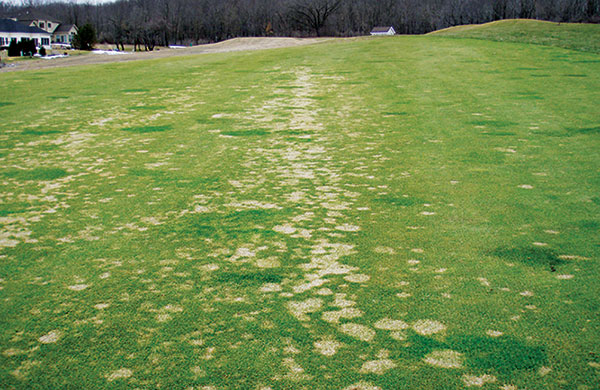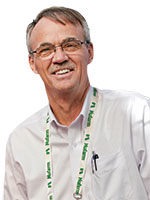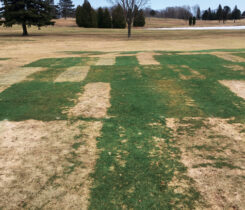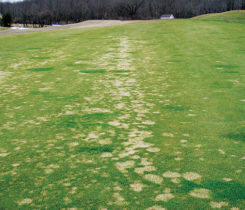Experts’ Insights: Shut down snow mold

Gray snow mold typically appears in places that experience long periods of snow-covered ground. (Photo: Paul Koch)
Snow mold is an umbrella term that encompasses pink snow mold, gray snow mold and speckled snow mold, according to Paul Koch, Ph.D., assistant professor in the Department of Plant Pathology at the University of Wisconsin-Madison.
It’s mostly found in areas that experience prolonged stretches of snow-covered ground (gray and speckled snow mold) or prolonged stretches of cool, wet weather with temperatures of less than 40 degrees F and high moisture (pink snow mold).
“The snow cover provides a nice warm blanket for the fungi to grow during the winter,” Koch says. “If it’s too cold and if there’s no snow there, the ground dries out, it freezes and the fungi don’t grow.”
Pink snow mold has a pinkish ring around the outside. Gray snow mold and speckled snow mold produce spores embedded in the leaf blade. The spores are red in color for gray snow mold, and they’re small and black in color for speckled snow mold.
It most commonly requires preventive applications of fungicides, sometimes in the late fall within two to three weeks of when the snow cover occurs. Koch recommends leaving a check area where superintendents spray snow mold products to get an idea of how much pressure is present.
“It’s seeing what your course experiences and then tailoring your program to fit that,” Koch says.

Paul Giordano (Photo: Bayer)
Bayer
Paul Giordano
Green Solutions Team member, Bayer Turf and Ornamental Division
Difficult settings in northern and high-elevation climates that experience extended snow cover, late season rains, unfrozen soils and repeated melting events tend to enhance snow mold pressure. Limiting shade, minimizing compaction and traffic, maintaining adequate fertility and maximizing other cultural practices can help mitigate pressure from snow mold pathogens. Many superintendents also have started to incorporate a midfall fungicide application to highly susceptible and high-value areas two to four weeks prior to their final snow mold application. Demethylation inhibitor fungicides have been shown to work well in preventively controlling early inoculum activity at this time. Advancements in molecular genetics and metabolic profiling may render new targets for synthetic- and biologic-based disease control solutions.

Rick Fletcher (Photo: Nufarm)
Nufarm
Rick Fletcher
Technical Services Manager, Turf and Ornamentals
Snow mold for most superintendents is a historic disease. If they’ve had it in the past or if they’re in a region that’s likely to get it, they know it could be prevalent at their place. Proper planning and timing of applications always is key. It’s understanding the opportunity to have snow mold, understanding the history of growth conditions, understanding the historical efficacy of their own experiences as well as university trials so that the timing of applications is adequate. Chemical choices can vary by region, by course and by the types of snow mold. Recently, the succinate dehydrogenase inhibitor families have played an important part. If anything’s going to change in the future, it’s going to be the involvement of other chemicals — chemical mixtures, chemical rotations that best suit the snow mold organisms at each course. It’s clear that mixtures of multiple active ingredients are essential for good management.

Justin Stewart (Photo: Corteva Agriscience)
Corteva Agriscience
Justin Stewart
Eastern District Sales Leader for Corteva Agriscience Turf & Ornamental
Proper identification of all snow mold types and the environmental conditions that favor each one is critical to achieving successful control. Avoiding excessive amounts of nitrogen going down in the late fall is often a great start. During this time, some superintendents utilize slow-release fertilizers in areas with a history of snow mold. Other options are to continue mowing into dormancy and applying one to two applications of fungicides prior to snowfall in order to “put the course to bed” before winter. Most universities recommend applying fungicides every three to four weeks in the absence of snow cover until temps start to exceed 60 degrees. Often just removing leaf clutter and installing snow fences can help reduce the potential for snow mold. In the future it’s possible that improved turfgrass varieties and advancements in digital tools for tracking nutrient use and disease outbreaks will someday provide superintendents with new ways to better control these diseases.

Matt Giese (Photo: Syngenta)
Syngenta
Matt Giese
Technical Services Manager
Culturally speaking, to circumvent snow cover on a tall canopy, avoid heavy applications of nitrogen in late fall that create lush turf. Also, minimize thatch accumulation and continue mowing until growth stops. Certain high-snow regions may see reduced disease from snow removal during the late-winter period. These practices, while helpful, may not be enough to alleviate snow mold damage to many susceptible turfgrass species, so consider a program of both cultural practices and preventive fall snow mold fungicide applications. In the longer term, we’ll likely see new active ingredients make an impact, although application timings won’t be that different from what’s currently recommended. What may drive this technology more than any other factor is how the changing climate affects snow mold pathogen types. It’s probably more accurate to say that predicting snow mold propensity is unpredictable, and superintendents managing it must continue to do so well into the foreseeable future.












